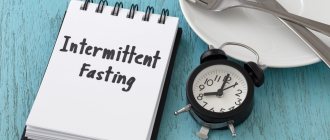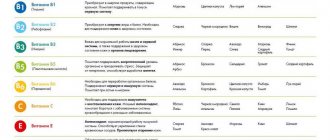Intermittent fasting, cyclical, periodic - these are all names of a nutritional scheme in which periods of complete refusal of food and its intake are clearly separated. There are several schemes: 16/8 - the most common, 14/10, 20/4 (the most difficult for beginners).
You can fast for 36 hours straight or follow the principle of 5 days eating and 2 days fasting. The results will not only be weight loss, but also an improvement in overall health: this strengthens the immune system, slows down the aging process, and improves performance.
The most popular 16/8 intermittent fasting scheme is recommended for 1 week, 1-2 times a month. Even after 7 days of the diet, you can see a weight loss of 2-5 kg.
What is intermittent fasting for weight loss?
Intermittent fasting is a nutrition system during which you can eat any food, but within a certain time interval. The interval nutrition system does not imply any restrictions on products and calories. It is important to eat at a certain time interval, which you can choose yourself, for example from 12 noon to 8 pm or from 9 am to 5 pm. The ability to vary the time of eating and the absence of prohibitions and other restrictions makes intermittent fasting so popular and loved by those who practice it.
Intermittent fasting is supported by a large number of supporters because the system has a scientific basis that is supported by practical research. Four years ago, biologist Yoshinori Ohsumi from Japan received the Nobel Prize in Medicine and Physiology. He studied the mechanism of autophagy (the ability of a cell to clean itself). The cell contains an organelle called a lysosome. It collects waste products, in other words, garbage. The lysosome is then broken down, turning into a simple substance that is again used by the cell.
An interesting point was the fact that from the biologist’s study, the relationship between autophagy and starvation was derived. A study of brewer's yeast showed that when there was nutrition, autophagy occurred slowly, and when there was not enough nutrition, it happened quickly. However, Yoshinori Osumi did not draw any conclusions about the human body and the effect of fasting on it. No experiments have been conducted on humans.
A lot of people are interested in fasting, I understand. But I am a researcher who has worked with yeast cells, which is what my research is based on. “I haven’t gone very far into how fasting affects health and life expectancy, so I won’t be able to answer,” the biologist answered questions during the conference, which took place in January 2022.
When Yoshinori Ohsumi was tormented with questions about fasting during a conference, he expressed his opinion:
We don't have evidence of whether fasting promotes autophagy, how beneficial it is for health... I think people have certain limitations. We did these trials in mice, but there is no confirmation that the same fasting would work well in humans. We need to do more testing on what kind of fasting is beneficial, because certainly not every type is beneficial. In fact, it all depends on people's lifestyle.
Other researchers in the field have described that the following changes are stimulated in the body during periods of fasting:
- When the body is in a state of hunger for several hours, sensitivity to insulin increases, due to which blood sugar levels and carbohydrate metabolism are stabilized.
- The body gets used to the feeling of hunger without inconvenience or discomfort. Long breaks between meals become easier to bear.
- During the period of lack of nutrition, burning of adipose tissue begins, i.e. energy is taken from stores, not from glycogen from the liver.
- Intermittent fasting helps improve immunity.
- During the period of intermittent fasting, the eating interval decreases, which means the number of meals also decreases. This reduces daily caloric intake, which promotes weight loss.
If you eat more than your daily allowance during the meal interval, you will not be able to lose weight. Intermittent fasting ideally helps to reduce daily food intake; there is no need to try to eat your daily allowance in 8 hours.
But there is not yet sufficient information and knowledge about how intermittent fasting affects the body. However, it is reliably known that any feeling of hunger contributes to stress in the body, and stress means “hello, excess weight.”
How does 6/18 intermittent fasting help with weight loss?
Jason Fung, MD, is a nephrologist (kidney specialist) and author of Intermittent Fasting. How to Restore Your Body, Lose Weight, and Boost Your Brain,” explained that intermittent fasting can help you burn fat by lowering insulin levels.
This is different from the typical weight loss method suggested by most experts, which is calorie restriction. Dr. Fung said that if you reduce your calories from 2,000 to 1,500 per day (to create a 500-calorie deficit), the body will be forced to lower its metabolic rate. A slower metabolism causes you to feel cold, tired and hungry. Weight loss eventually plateaus, meaning you need to eat even less to lose weight, which is not sustainable.
Pond5
see also
Simple tips from experts to help you lose weight
This is why Dr. Fung stated that calorie restriction diets do not work, which was also proven by the contestants on the weight loss TV show "The Biggest Loser."
A major study of former contestants found that a period of intense calorie restriction and weight loss disrupted their metabolism, leaving them requiring far fewer calories to maintain their new weight than before they went on the show. Most of the contestants ended up regaining most, if not all, of the weight they lost during the show.
Dr. Fung also works with patients with diabetes, and he says fasting has helped them lose weight, reverse or slow down their diabetes, and stop taking medications.
“When insulin levels are low, the body can draw energy from fat stores,” he said.
Many people who fast actually find that their hunger decreases, so intermittent fasting can help people who are prone to overeating. When doing any form of daily intermittent fasting, you aim to eat the day's calories, only in a shorter meal time.
The benefits of intermittent fasting
A diet called intermittent fasting has a large number of benefits, unlike diets. The 16/8 weight loss regimen is less hazardous to health than diets with severe restrictions.
There are no strict limits to intermittent fasting; you don’t have to change your diet, just reduce it a little. This will avoid stress due to dietary changes.
Stress resistance will increase and immunity will be strengthened.
The 16/8 intermittent fasting scheme is very flexible, since you can choose the 8-hour eating interval yourself. This will allow you not to change your daily routine. You can even change the scheme, if it’s easy for you or, on the contrary, difficult, you can choose intermittent fasting according to the 14/10 and 18/6 schemes.
Although it is better not to exceed the daily caloric intake, it is not necessary to count KBJU. This will allow you to give up daily math. But in this case, it is better to adhere to the plate rule so as not to overeat.
During the fasting period, you can drink tea, coffee, drinks diluted with water (in a ratio of 1 to 1). This will allow you to withstand hunger.
You can choose the number of meals yourself. For example, breakfast, a snack and dinner or lunch and two snacks. This will allow you to adjust your nutrition to your daily routine.
You won't have to cook all the time, you'll need less food. This will save your budget.
No additional financial costs are needed.
Intermittent fasting does not require special nutrition or calorie reduction. This will make it very easy to tolerate this diet.
During fasting, insulin levels decrease and cells become sensitive to it. The body begins to process fat more actively. There is research showing that intermittent fasting reduces the risk of type 2 diabetes.
16/8 intermittent fasting does not slow down your metabolism. This will help you lose weight.
With an interval diet, the body receives all the necessary nutrients and vitamins. This will keep you healthy.
Intermittent fasting 16/8 can be followed for a long time.
results
When a person eats, insulin increases in the blood, and metabolic processes slow down significantly. This is the beginning of weight gain, obesity is possible. All processes during fasting are aimed at restoring the health of the body. With a lack of calories, the level of sugar and insulin in the blood significantly decreases, while the concentration of growth hormones increases. A feeling of hunger appears. At this moment, catecholamines are sent to fat cells, starting the process of burning subcutaneous fat in problem areas. In this way you can not only lose weight, but also maintain muscle mass.
Cons of Intermittent Fasting
Each diet has its own negative sides and manifestations:
- Fatigue and bad mood due to hunger.
- Headaches and dizziness.
- Increased desire to eat, obsessive thoughts.
- Overeating during the permitted period.
- Increased risk of developing digestive disorders (constipation, diarrhea, increased gas formation, etc.).
- Heartburn and belching are possible.
- Leg spasms and cramps may appear.
- Disorders of the menstrual cycle in women.
- In the evening, a person’s social life most often manifests itself. Going to cafes and dinners with friends become difficult moments in life.
- To make it easier to endure periods of hunger, you will need a fairly varied menu.
- Lack of evidence for intermittent fasting in the long term. All available studies were conducted in the short term.
Most often, most of the listed points are temporary and go away after a couple of days of dieting.
Contraindications to intermittent fasting
Although the 16/8 intermittent fasting regimen is the safest, there are still a large number of contraindications:
- Age – less than 18 years. The body is still growing and even small problems with diet can trigger the development of many diseases in the future.
- Pregnancy and breastfeeding periods.
- Recent medical procedures and surgeries.
- Gout, gastritis and other gastrointestinal problems. These diseases require special diets.
- Diseases of the gallbladder, kidneys, liver, pancreas.
- Psychological diseases.
- Oncological diseases.
- Body weight deficiency.
- Diabetes mellitus, autoimmune diseases and problems with the endocrine system.
- Atrial fibrillation.
- A period of illness and fever.
- Severe diseases associated with the cardiovascular system.
Thus, to be sure whether intermittent fasting is right for you, you need to know the list of your diseases. It is recommended to undergo a medical examination and obtain permission from a doctor, because as you can see for yourself, there are a lot of contraindications.
Rules for intermittent fasting
Intermittent fasting for women is much safer for health than various restrictive diets. This is a fairly flexible nutrition system, but it also has its own rules that contribute to effective weight loss. For a positive result from fasting, you must follow the following rules:
- During the fasting period, you cannot eat. If your hunger is very strong, then it is better to drink tea with herbs or lemon and mint; in the morning you can drink coffee, including with milk.
- During fasting periods, you should not drink juices from packages or soda. They contain huge amounts of sugar.
- If you feel unwell during a fast, you are plagued by dizziness and loss of strength, then you should urgently give up intermittent fasting.
- During the eating interval, do not exceed your daily caloric intake. You can eat any food as long as it generally does not exceed the daily norm.
- Intervals should be arranged so that the last meal occurs at least 4 hours before bedtime. Eating at night can ruin your sleep.
- Breakfast should be as high in calories as possible.
- All meals should contain proteins, fats and carbohydrates.
- You should not make unhealthy snacks and eat processed foods and fast food.
- The last meal should not contain fast carbohydrates. A sharp increase in blood sugar can contribute to poor health.
- Do not fast for more than 16 hours, although there are such eating plans, but it is better to abandon them. With prolonged fasting, metabolism begins to slow down, and the body enters the reserve stage.
Opposite opinion of a dietitian, nutritionist and therapist
According to Alexandra Razarenova, a dietitian and nutritionist (the full interview can be read on the pages of rbc.ru):
“Hunger is a serious stressor. To meet energy needs, the body uses reserves - fat and muscle tissue. Fasters are inspired by the idea that fasting burns fat. But they forget (or maybe don’t realize) that, without a source of protein from the diet, the body uses its own muscles as a building material for the synthesis of hormones, tissue renewal, digestive enzymes and other biologically active substances necessary for normal functioning.
By losing muscle mass, a fasting person sharply reduces his basal metabolism. And then the most unpleasant thing happens - having returned to his normal life, the person, due to incorrect eating habits and long-term restriction, gains weight again. But no longer due to muscle mass, but due to adipose tissue.”
A classic trap for many people who are losing weight, by the way. Most people who diet (without maintaining physical activity to maintain muscle mass and without consuming protein) will regain more weight than they lost, but with a higher percentage of fat rather than muscle tissue.
“A new round of diet is more likely to no longer be as effective as the previous one. With low amounts of muscle tissue, your metabolism will be reduced. Restriction in food or its complete absence leads to vitamin deficiencies, microbiota imbalance, decreased immunity and general exhaustion,” the nutritionist specialist sums up the interim summary.
And according to the doctor, the maximum time a person can spend without food to remain healthy is 12 hours, but in no case while awake.
Intermittent fasting schemes: 10/14, 12/12, 8/16, 4/20, 6/18, 5-2
Many of you may already be doing the 10/14 or 12/12 intermittent fasting plan. For example, if you eat from 10 am to 8 pm or from 12 pm to 10 pm. This is the softest nutrition plan. But there are also more strict schemes - 18/6, 20/4, 24/0 and 5-2. More information about intermittent fasting plans:
- Intermittent fasting 10/14 and 12/12 . The schemes are very simple, almost every person eats them.
- Intermittent fasting 18/6 . You cannot stick to this diet plan for a long time. Such prolonged fasting can contribute to a slower metabolism.
- Intermittent fasting 20/4 . This is express weight loss before a certain date. Suitable for those who urgently want to lose weight for a wedding, vacation, event and other events. You cannot follow this regimen for more than one week, since you will not receive the necessary nutrients and vitamins due to the fact that you only have one meal per day.
- Intermittent fasting 24/0 (Eat - Stop - Eat) . There is no need to follow this intermittent fasting pattern. Lack of hunger will lead to a slowdown in metabolism and health problems may arise.
- Intermittent fasting 5-2 . The scheme is combined with the previous one - 24/0, as it involves 5 days of food and 2 days of no food. The scheme is also unsafe for health and may turn out to be completely ineffective if you eat indiscriminately for 5 days.
The most optimal and safe scheme is 16/8. The scheme is the most popular among adherents of intermittent fasting.
The benefits and harms of diet
The system of intermittent fasting has many undeniable advantages. Some of them are even confirmed by scientific research.
However, you should only practice intermittent fasting, especially if you have health problems, after consulting with your doctor. Otherwise, there is a risk of developing problems with the gastrointestinal tract and other organs.
Positive sides
- Intermittent fasting teaches self-control. Over time, a person learns to distinguish true hunger from the psychological need to chew something.
- The slow rate of fat burning is compensated by a guarantee of lasting results.
- The benefit of periodic fasting is that recovery processes are activated. The body replaces damaged cells with new, healthy ones, removes old ones or uses them to release energy.
- Scientists from Southern California published an article in 2014 claiming that cells in the defense system regenerate better during periods of fasting. The body tries to save energy and recycles damaged immune system cells. During fasting, the number of old white blood cells decreases, but after eating food, new ones are produced and the number returns to normal.
How to start intermittent fasting
It is necessary to start intermittent fasting gradually, it is not necessary to immediately start with 16/8, try 14/10 first, then move on to a more complex regimen.
At first, you can change the interval as you wish in order to develop the most convenient scheme for yourself. It should easily adapt to your regime.
Drink more fluids, maybe tea or coffee. More fluid dulls the feeling of hunger.
During intermittent fasting, sleep should be complete – at least 8 hours.
Intermittent fasting is easier if you keep busy. A weekend at home watching TV series will be very difficult to endure.
Make a list of useful and enjoyable things to do on different days. This will make it easier to survive hunger.
Everything should be in moderation - fasting, even according to the easiest plan, should not be on an ongoing basis.
If you don’t like to have breakfast in the morning, then choose the interval from 12-13 pm until 20-21 pm.
If you don’t like to have dinner late, then choose the interval from 8-9 a.m. to 4-5 p.m.
The best option, suitable for the majority, is from 10-11 am to 18-19 pm.
For the 8-hour eating period, it is necessary to think over a diet that will fit into the KBZHU of the day.
What is 16/8 Intermittent Fasting?
For gaining pure mass, this method is especially productive, especially since high-quality and healthy products are included in the daily diet. The essence of the method is to divide the day into two time intervals - the period of food consumption and the fast. This type of cyclic fasting involves 16 hours of complete abstinence from eating and 8 hours of eating. At first it may seem unrealistic, but you need to remember the sleep phase, which already lasts 7–9 hours and occurs without eating.
If you add another 7–9 hours, the hunger strike ends and you can eat. You should start with a 3-4 hour fast after waking up, i.e. have breakfast only at 12 o'clock, when the so-called eating window opens. By this time, appetite increases noticeably, and hunger can be satisfied after a long period of abstinence from food. Beginners and professional athletes have chosen this technique and supplement it with regular training to enhance metabolism and intensive release of hormones. Below is a brief description of the two periods:
- Hunger strike. Solid food is strictly prohibited, only water and drinks without calories are allowed, for example, green tea without sugar or coffee without any additives (milk, cream).
- Food window. During this period, you need to eat the daily amount of calories, giving preference to fractional meals. The first meal should be chosen as high in calories as possible, the rest will be light and will not overload the stomach.
Intermittent fasting and training
Since your nutrition now depends on time, your workouts will have to be adjusted to your nutrition or vice versa. Training usually takes place in the morning or evening, i.e. before or after work. Exercising on an empty stomach is quite difficult, especially if you do strength exercises.
During intermittent fasting, workouts should be in the evening, about an hour before your last meal. If your interval ends at 9, then your workout should be at 8 o'clock. Cardio training does not have to be postponed; aerobic training is useful on an empty stomach for fat burning. If you are not tied to work and can exercise at any time of the day, then exercise between meals, 1-3 hours after breakfast or lunch.
Exercise combined with intermittent fasting speeds up the process of weight loss. According to the 16/8 fasting schedule, the fasting interval will not have any negative effect on the muscles, they will remain in place.
Most importantly, feel your body; if you are having a hard time training, you should reconsider your diet or reduce the intensity of your exercises.
Preparation
Certain preparatory measures for intermittent fasting, for example, reducing the calorie content of the daily menu or conducting a course of cleansing enemas, are not required. There is also no need to introduce strict restrictions on the number of daily meals. The only requirement is a final decision to lose weight and the desire to achieve your goal. To make this new stage in your life much easier, here are valuable recommendations from nutritionists:
- switch to proper nutrition;
- check kidney function (exclude extensive pathologies);
- control the body’s water regime;
- do not overeat, avoid obesity;
- control the total caloric content of dishes.
There are also no specific recommendations regarding exit from cyclic fasting. From the experience of athletes, it becomes obvious that at first a person who has lost weight should not overeat, otherwise he will suffer from indigestion, nausea, heartburn, heaviness in the stomach, and general weakness. Food should be light, always balanced and fortified. Therefore, a gradual exit from the already habitual state of hunger strike is important. It is important not only to lose weight, but also to improve your own body health.
Intermittent fasting menu for weight loss
Intermittent fasting involves skipping several meals. Therefore, it is necessary to correctly distribute food and determine the required amount of KBZHU.
Approximate nutrition menu for intermittent fasting according to the scheme 14/10 and 12/12
The 14/10 intermittent fasting pattern involves eating for 10 hours and fasting for 14 hours. The 12/12 schedule is divided into 12 hours of fasting and 12 hours of eating. It is with these schemes that it is recommended to start intermittent fasting, so that it is easy to come to the 16/8 scheme.
In the first case , according to the 14/10 scheme , you can eat for 10 hours. It is better to take your last meal no earlier than 3-4 hours before bedtime. For example, if you go to bed at 12 o'clock, then it is better to have your last meal at 8-9 o'clock in the evening. In this case, the eating period is from 10-11 am to 8-9 pm. This is one of the lightest versions of intermittent fasting, because a large number of the population eats it and does not even assume that they are following one of the intermittent fasting schemes.
The approximate menu depends on the number of calories needed. Here you can calculate your daily calorie intake (remember to multiply your basal metabolic rate by your activity factor).
Meals during intermittent fasting according to the 14/10 scheme may consist of:
- Breakfast at 10 am (break 4 hours).
- Lunch at 2 pm (break 3 hours).
- Snack at 5 pm (break 3 hours).
- Dinner at 8 pm.
Menu option according to the intermittent fasting scheme 14/10
Breakfast 10:00
Pancake with cottage cheese and banana
Ingredients for 1 serving:
- Flour 30 gr
- Chicken egg 1 piece
- Natural yogurt 50 gr
- Baking powder 1/3 teaspoon
- Sugar 1 teaspoon
- Soft cottage cheese 80 gr
- Banana 60 gr
Preparation:
- Mix the ingredients for the dough: flour, egg, yogurt, baking powder, sugar.
- Cook the pancake in a non-stick frying pan for 2-3 minutes on each side or in a regular frying pan with a drop of oil.
- Place cottage cheese and chopped banana on the pancake.
- Fold the pancake in half.
Lunch at 14:00
Pasta Bolognese
Ingredients for 1 serving:
- Minced beef 80 gr
- Pasta 60 gr
- Tomato paste 50 gr
- Onion 20 gr
- Creeping garlic
- Russian/Gouda cheese 10 gr
- Tomatoes 30 gr
Preparation:
- Fry the onion, garlic and minced meat until golden brown. Add spices and salt to taste.
- Add tomato paste and a little water. Simmer covered for 10-15 minutes.
- Boil the pasta according to the instructions on the package. Add minced meat to pasta.
Snack at 17:00
Grain cottage cheese 130 g and apple.
Dinner at 20:00
Caesar roll
Ingredients:
- Lavash or flatbread
- Chicken fillet fried or boiled 70 g
- Lettuce leaves 20 gr
- Tomato 100 gr
- Russian/Gouda cheese 30 gr
For refueling:
- Natural yogurt 50 gr
- Creeping garlic
- Mustard 1 teaspoon
Preparation:
- Mix the ingredients for the sauce.
- Chop the chicken fillet, tomato, three cheeses, and tear off the lettuce leaves.
- Assemble the roll: spread the sauce on the flatbread, lay out the ingredients and roll it up into an envelope.
According to the 12/12 intermittent fasting scheme, you can eat for 12 hours. If you take your last meal at 8-9 o'clock in the evening, then you can eat your first meal at 8-9 o'clock in the morning. This is the lightest version of intermittent fasting. You can use it to get in and out of intermittent fasting. You can always eat on the 12/12 plan; it corresponds to the norms of proper eating behavior
Meals during intermittent fasting according to the 12/12 scheme may consist of:
- Breakfast at 8 am (break 4 hours).
- Lunch at 12 noon (break 4 hours).
- Snack at 16:00 (break 4 hours).
- Dinner at 8 pm.
The 12/12 intermittent fasting menu option can be taken from the diet presented above.
Approximate nutrition menu for intermittent fasting according to the 16/8 scheme
The 16/8 intermittent fasting scheme is the most popular among adherents of this diet. It is this scheme that those losing weight strive for; the remaining schemes are necessary either for entering and exiting intermittent fasting or for express weight loss. Intermittent fasting 16/8 involves rational weight loss with all the additional advantages.
According to the 16/8 scheme, you can eat only 8 hours a day, you must fast for 16 hours. The diet is not complicated, but involves only main meals. It is better to eat your last meal 4 hours before bedtime. For example, if you go to bed at 12 o’clock at night, then it is advisable to have your last meal at 8 o’clock in the evening, then the first one at 12 o’clock in the afternoon.
Meals during intermittent fasting according to the 16/8 scheme may consist of:
- Breakfast 12 noon (break 4 hours).
- Lunch at 4 pm (break 4 hours).
- Dinner at 8 pm.
Menu option according to the 16/8 intermittent fasting scheme
Breakfast at 12:00
Oatmeal with banana
Ingredients:
- Oat flakes 40 gr
- Milk 50 ml
- Chicken egg
- Cocoa 10 gr
- Baking powder 1/4 teaspoon
- Banana 50 gr
- Olive oil half a teaspoon
Preparation:
- Mix the ingredients for the pancake: cereal, milk, egg, cocoa, baking powder.
- Bake the pancake in a frying pan greased with olive oil or in a non-stick frying pan for 2-3 minutes on each side.
- Slice the banana, place it on the prepared oatmeal pancake and fold it in half.
Lunch at 16:00
- Chicken drumstick, baked or boiled 70 gr.
- Buckwheat porridge 70 gr.
- Salad with tomato, cucumber, bell pepper and a drop of oil 180 gr.
Dinner at 20:00
- Chicken cutlet 70 gr.
- Brown rice 70 gr.
- Greek salad 180 gr: cucumber, tomato, bell pepper, onion, feta cheese, olive oil.
Approximate nutrition menu for intermittent fasting according to the 18/6 and 20/4 scheme
Intermittent fasting according to the 18/6 scheme involves fasting for 18 hours, you can only eat for 6 hours. This diet includes two main meals and one snack. You can choose your own meal time to make it convenient.
Meals during intermittent fasting according to the 18/6 scheme may consist of:
- Breakfast at 1 pm (break 3 hours).
- Snack at 4 pm (break 3 hours).
- Dinner at 7 pm.
Menu option according to the 18/6 intermittent fasting scheme
Breakfast at 13:00
- Fry 40 grams of raw smoked bacon (for example, “Dymov”) in a frying pan without oil.
- Fry two eggs with bacon.
- We cut one cucumber and take a few lettuce leaves.
Snack at 16:00
Bruschetta
Ingredients:
- Tomato 70 gr
- Greens to taste
- Creeping garlic
- Slice of bread 2 pcs
- Oil 1/2 tsp.
- Vinegar 1/2 tsp.
Preparation:
- Rub the bread with garlic. Fry in a frying pan.
- Finely chop the tomato, add herbs, oil, vinegar.
- Spread the tomato mixture onto the bread.
Dinner at 19:00
Brown rice with baked cod with cheese and tomato and cucumber salad with a drop of oil.
Ingredients for cod with cheese:
- Cod fillet 100 gr
- Russian/Gouda cheese 50 gr
- Sour cream 50 ml
- Mustard 1 teaspoon
- Salt and pepper to taste
Preparation:
- Grate the cheese.
- Add sour cream and mustard. Mix well.
- Place the cod fillet in the pan, add salt and pepper. Place cheese sauce on top.
- Bake in the oven at 180 degrees for 20-25 minutes.
Intermittent fasting according to the 20/4 scheme is more strict; you cannot adhere to such a diet for more than a week. It is assumed that you can only eat for 4 hours, you must fast for 20 hours. You can only eat twice within 4 hours. You can choose the interval yourself according to your daily routine.
Meals during intermittent fasting according to the 20/4 scheme may consist of:
- Breakfast at 2 pm (break 4 hours).
- Dinner at 6 pm.
Menu option according to the 20/4 intermittent fasting scheme
Breakfast at 14:00
Chicken breast with pineapple, boiled pasta, tomato and cucumber.
Ingredients for Chicken Breast with Pineapple:
- Chicken breast 120 gr
- Pineapple 100 gr
- Curry 5 g
- Lemon juice 5 g
- Olive oil 5 g
Preparation:
- Grind the pineapples, add curry seasoning, squeezed lemon juice, and salt.
- Mix half of the resulting sauce with olive oil.
- Remove skin from chicken breasts and brush with half the sauce.
- Bake for 30 minutes at 180 degrees.
- Serve the remaining sauce with the finished dish.
Dinner at 18:00
Merchant style buckwheat and salad with cabbage, carrots and a drop of oil.
Ingredients for merchant-style buckwheat:
- Beef 100 gr
- Buckwheat 40 gr
- Small onion
- Small carrots
- Garlic 1 small clove
- Salt, spices to taste
Preparation:
- Cut the meat and onions into cubes, three carrots on a track, chop the garlic.
- Fry the meat until a crust forms, add salt.
- Add onions, carrots, garlic. Stir and fry for 3-4 minutes.
- Add buckwheat, distribute in the pan, add water to completely cover the ingredients, add a little salt. Cover with a lid and simmer for 15-20 minutes.
Popular power plans
Having studied the basic principles of intermittent fasting, you can easily understand the schemes presented below. Each of them is based on two numbers: the first indicates the duration of the hunger phase, the second (usually smaller) the duration of the eating window.
The schemes are mainly developed by athletes and bodybuilders - it is possible that for the purpose of self-promotion. But the fact remains that they quickly spread across the Internet as an effective way to achieve a goal and found their audience of admirers.
It is impossible to say which scheme will be optimal for you personally. We recommend that you first try the simplest ones, for example, 14/10, and only then move on to more complex ones - for example, the 20/4 scheme, in which only 4 hours are allocated for eating.
Beginner circuit: 12/12 or 14/10
The 12/12 and 14/10 schemes are best suited for beginners who are not yet familiar with intermittent fasting and are more inclined to eat fractional meals. The scheme has practically no restrictions or frameworks, except for those that everyone defines for themselves.
© Alya_del — depositphotos.com
Intermittent Fasting 16/8 Martin Berhan
In his blog, Martin Berkhan, a well-known US journalist, trainer, nutrition consultant and part-time bodybuilder, reports that he is not averse to drinking alcohol without having breakfast, working out on an empty stomach, or eating something sweet.
His methodology was based on several elementary rules:
- Observe a fasting period of 16 hours every day.
- Train intensively on an empty stomach several times a week.
- Before or during physical activity, take 10 g of BCAA.
- On training days, the menu should contain large portions of protein, as well as vegetables and carbohydrates.
- The largest meal follows immediately after exercise.
- On non-workout days, the emphasis is on protein, vegetables and fats.
- Foods should be minimally processed, mostly whole, without additives.
In addition, Berhan claims that the intermittent fasting system not only reduces weight, but also helps build muscle. Weight gain improves when the regimen is divided into pre-workout food intake (no more than 20%) and post-workout (50-60% and 20-30%).
Mode 20/4 by Ori Hofmekler
“If you want the body of a warrior, eat like a warrior!” Ori Hofmekler thunders in his book “The Warrior Diet.” On its pages, in addition to the life philosophy from an artist with a higher education, the basic rules of the diet for men are outlined.
The advantage of the warrior diet is its simplicity: you don’t have to count, weigh or alternate anything.
It is only important to follow a few rules and divide the day into a phase of hunger and overeating:
- Intermittent fasting 20/4 is 20 hours of fasting and 4 hours of eating. True, during the fasting phase it is allowed to drink freshly squeezed juice (preferably vegetable juice), snack on nuts, fruits or vegetables.
- Ori also recommends training on an empty stomach.
- After class, you can drink kefir or yogurt, and also eat a couple of hard-boiled eggs.
- In the evening, the long-awaited phase of the feast comes: you are allowed to eat almost everything, but you will have to follow a certain order: first fiber (fresh vegetables), then proteins and fats, and carbohydrates for a snack.
© viarunia — depositphotos.com
Interval nutrition 2/5 Michael Mosley
The essence of the scheme proposed by Michael Mosley comes down to the fact that 2 days a week, daily calorie intake must be reduced to a minimum. For women only 500 kcal, and for men 600 kcal. The rest of the time, that is, 5 days, you are allowed to eat normally, consuming the daily allowance calculated by weight and activity.
Research on the effectiveness of this scheme was conducted at the University of Florida. The subjects followed a diet for 3 weeks. Throughout the period, their body weight, blood pressure, glucose levels, cholesterol levels, inflammatory markers and heart rate were measured.
Scientists noted an increase in the amount of protein responsible for the activation and functioning of the antioxidant system, which prevents aging. The researchers also documented a decrease in insulin levels and suggested that intermittent fasting prevents the development of diabetes.
The fact that the eating window is limited in time and moved closer to the afternoon reduces the risk of overeating. Sticking to PG is convenient for people who have no appetite in the morning and are drawn to the refrigerator in the evening. In addition, adherence to the regime allows you to introduce your usual social life, exercise, and at the same time not restrict your diet.
Brad Pilon's fasting for weight loss
The regime, which quickly gained popularity and spread across the Internet, could not be ignored by women eager to lose a few extra pounds.
When it comes to intermittent fasting for weight loss, designed specifically for women, the system most often mentioned is that of Canadian fitness trainer Brad Pilon, which is called “Eat-Stop-Eat.” In addition to theory, practical research was carried out. More than half of the participants – about 85% – confirmed the effectiveness of the technique.
It is based on the common principle of calorie deficit: a person loses weight when he spends more energy than he consumes food.
In practice, the regime requires compliance with three rules:
- During the week, eat as usual (it is advisable to adhere to the principles of a healthy diet and not overeat, but it is not necessary to strictly count calories).
- Two days a week you will have to limit yourself a little - give up breakfast and lunch, but you can have dinner. The evening meal should consist of meat and vegetables.
- During the “hungry” day, you are allowed to drink green tea without sugar and water.
You can stick to this regimen for a long time, but it is important to understand that the rate of fat loss depends on many factors: weight, age, physical activity, and diet in addition to the regimen.
© happy_lark — depositphotos.com
Intermittent fasting tracking apps
Intermittent Fasting - Zero-Cal Fasting Tracker
- Availability Android and IOS – available
- Grade – 4,9
- Number of downloads – more than 5 million
- Download
- The application shows how long you are fasting and how much is left, depending on the chosen scheme.
- You can choose any intermittent fasting scheme or create your own.
- At each stage of fasting there are clues about what is happening to the body.
- Added the ability to track the amount of water you drink.
Intermittent fasting app from 5W Verlag GmbH
- Availability Android and IOS – available
- Grade – 4,5
- Number of downloads – more than 1 million
- Download
- Mandatory registration via email, Facebook or Google account
- Can connect Google Fit
- The tracker is designed for 14 days. There are nutritional recommendations for each day, including recipes for three main meals: breakfast, lunch and dinner. Recipes are available in the paid version (999 rubles forever).
- You can track the amount of water you drink.
- Added the ability to enter activities manually.
- You can upload before/after photos to the app.
- It is possible to track weight and girth.
- There is useful information on intermittent fasting.
Clear - Timer Intermittent fasting
- Availability Android and IOS – available
- Grade – 4,7
- Number of downloads – more than 500 thousand
- Download
- Most of the features are paid: weight and goal tracking, information on healthy eating, recipes, intermittent fasting schemes 20/4, 21/3, 22/2, 23/1.
- A convenient fasting countdown tracker that is always visible on the screen.
- All basic intermittent fasting schemes are available: 16/.8, 12/12, 11/13, 10/14, 9/15, 7/17, 6/18, 5/19.
- Tips for intermittent fasting.
Rules
With intermittent fasting, there are certain requirements, the observance of which helps to productively burn fat, maintain muscle mass, normalize digestion and cleanse the liver. Here are the rules in question:
- The daily calorie intake is selected individually, and it must be consumed during the eating window.
- You are allowed to eat from 2 to 8 hours; the rest of the time it is recommended to drink only clean water without gas.
- During the food window, it is important to completely avoid eating baked goods, fast food, fatty and fried foods, processed foods high in fat and carbohydrates, confectionery and flour products.
- During periods of hunger strike, you should lead an active lifestyle; you can play sports without the risk of burning muscle mass (it is recommended to exercise on an empty stomach).
- It is necessary to limit the intake of simple carbohydrates into the body and control the water regime. The acceptable daily water intake is 2 liters, more is possible.
- There are 3 main meals, between which you can snack on fresh vegetables and fruits.
- It is advisable to reduce the portions by half - no more than two fists in volume, be sure to reduce the daily calorie content of the dishes.
- Daily portions of animal fats should not exceed 50 g, and they must be consumed in the first half of the eating window.
Why it's better not to fast with intermittent fasting
As mentioned above, intermittent fasting for weight loss is the gentlest diet that is as safe as possible for the body. However, it's best not to practice intermittent fasting, and here's why:
- Whatever one may say, the point of the 16/8 scheme is to reduce the caloric content of the diet due to the fact that one meal will be eliminated. But isn’t it easier to leave this meal but reduce your daily calorie intake? Or remove lunch and add a snack instead.
- With intermittent fasting, you refuse to count KBJU, which is why you run the risk of going too far or missing calories, which is bad in both cases. There is a risk that the quality of your diet will deteriorate, it will be unbalanced, and you may not receive enough nutrients and vitamins.
- In order not to gain weight, but to lose weight, you still need to calculate your calorie intake and give up junk food and food waste. An abundance of sweets and fast food can lead to weight gain, deterioration of appearance and stomach problems.
- For those who eat small meals, with breaks of several hours, giving up food for 16 hours will be very difficult and difficult.
- A very recent study () showed that people who limit their food intake did not lose weight. This method is not effective unless you are in a calorie deficit.
12 717
How to calculate the required amount of calories consumed?
Diana Polekhina / unsplash.com
see also
How to eat whatever you want and still lose weight
By the way! To find out (approximately) your caloric needs, you'll first need to calculate your basal metabolic rate (BMR), which is your body's resting caloric expenditure, and your total daily energy expenditure (TDEE), which is the amount of energy used by humans or animals when moving and needed to maintaining the health of the body.
The first metric uses the Harris-Benedict formula to estimate approximately how many calories you should consume per day to lose weight, based on your total body weight, height, age, and gender:
for men:
BSM = 88.362 + (13.397 * weight in kg) + (4.799 * height in cm) - (5.677 * age in years);
for women:
BSM = 447.593 + (9.247 * weight in kg) + (3.098 * height in cm) - (4.330 * age in years)
Then you multiply the resulting indicator (BMR) by your activity level:
1,2if you lead a sedentary lifestyle;
1,375if you do light exercise one to three days a week;
1,55if you do moderate exercise six to seven days a week;
1,75if you are very active (heavy exercise every day or exercise twice a day);
1,9if you are very active (heavy exercise two or more times a day).
The resulting number will correspond to the number of calories your body burns daily. To lose weight, you will have to create a calorie deficit, meaning that your daily intake must be less than your energy expenditure (even if you are intermittently fasting).











